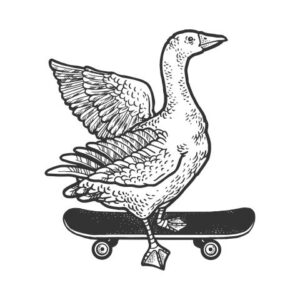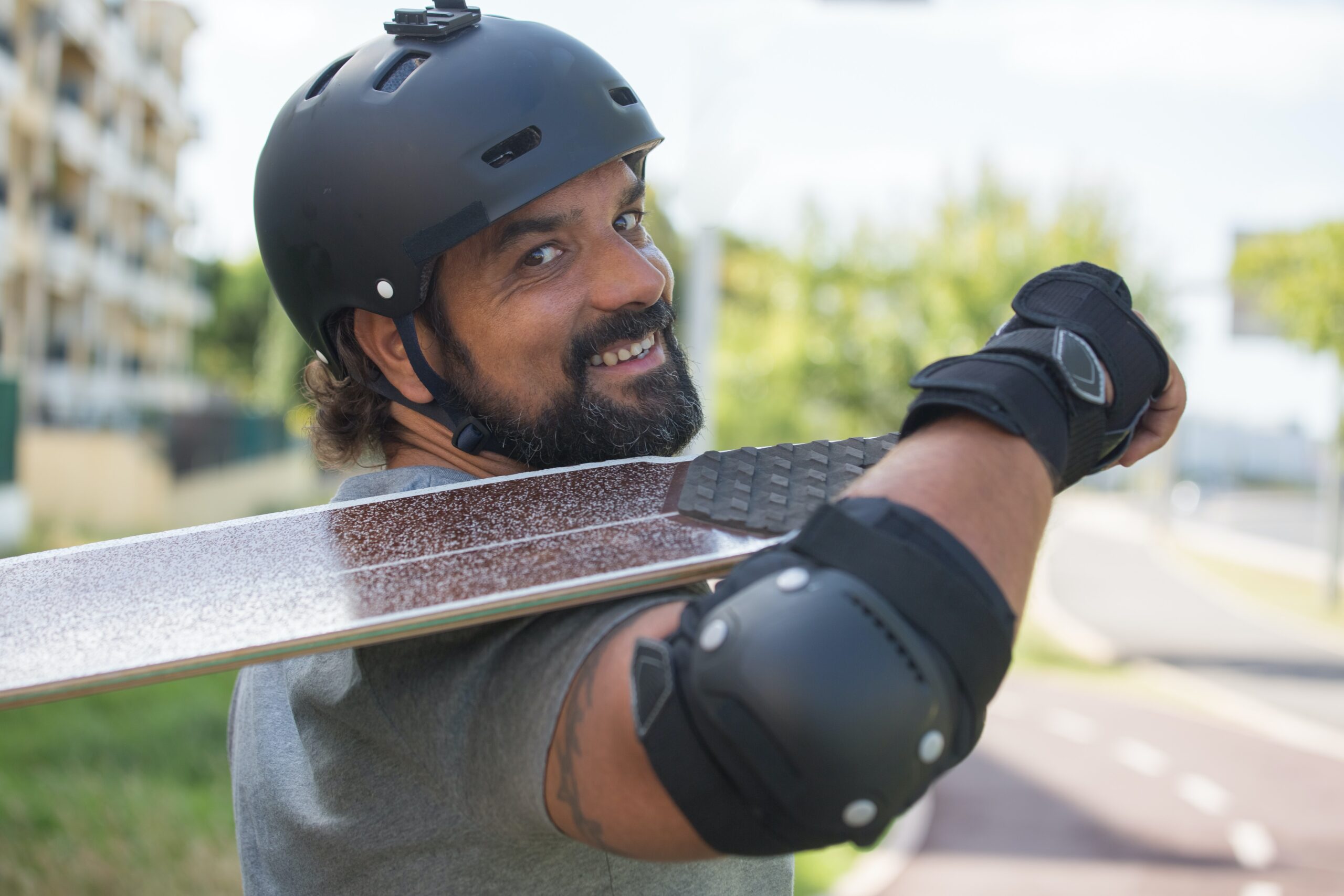So you have decided to embark on the most difficult of quests; going to the skatepark for the first time. Wow! I’m impressed with your bravery and know you’ll do great.
In the meantime, I’ll give you a run-down of basic skatepark etiquette, types of obstacles, and general tips to feel less nervous and get the most out of your skatepark trip.
So let’s dive right into it.
Skatepark Etiquette
Skatepark etiquette refers to how you are supposed to act in the skatepark. These unspoken rules are ingrained into skaters and not following them will frustrate and annoy other skaters.
These are rules you absolutely should follow while at the skatepark even as a beginner.
Where to Sit
Where to sit and rest at the skatepark can be confusing sometimes. Because many parks are designed for street style sometimes a bench that looks perfect for sitting is actually meant to be grinded. If you sit there, then you are in someone’s way.
The best advice I can give is to sit on the edge or outside of the park itself. When it comes to putting your bag somewhere, then the edge or outside the park is definitely where to do so.
Sometimes there can be parts of the coping or certain ledges that have somehow become spots where people sit and rest. This kind of varies from park to park and I would recommend just watching where the more experienced skaters are putting their bags and where they are resting.
Sharing the Park
There is a sort of ebb and flow to the skatepark that is hard to describe. You try to time your lines in such a way that doesn’t get in other people’s way. You will take turns skating a ledge or set of stairs not by standing in a line, but sort of as a cluster of people.
I’m not going to harp on this too much as it really just boils down to don’t be a jerk. If someone wants to skate an obstacle you’re skating, then let them.
For beginners, this is usually a non-issue. You don’t have the skills to put together lines anyway and beginners usually defer to other skaters regardless.
Yell “Board”
If you fall and your board goes flying away from you then yell “board”! This is a safety issue and being cool is not the priority here.
Honestly, there will be a lot of people who only sheepishly yell “board” or don’t say it at all. These are usually younger and shy teenagers or kids. The fact is that it could injure someone and you need to give a strong verbal warning.
You don’t have to yell like someone getting murdered, but loud enough for nearby skaters to hear.
Just do it.
Stay Out of the Bowl Unless Your Skating It
This is something that is very tempting to do as an absolute beginner. Go into an empty bowl. Place your board down and cruise a bit. I did this and in a completely empty skatepark, it’s fine.
Yet, when other people are at the skatepark this can cause very serious injuries. If you drop in and suddenly see someone hanging out at the bottom, you could easily take a nasty spill avoiding them.
So be cautious. When you first learn to drop in and carve, you won’t be able to get enough speed to smoothly get out of the bowl. So when you finish your run, climb out as quickly as you can.
I cannot emphasize this one enough as I believe it’s the most dangerous. If you see a kid doing this, tell them to get out. Explain to them why it’s dangerous.
Don’t Litter or Vandalize the Park
If you’re enjoying and using the skatepark, then don’t damage or trash it. So many skateparks are covered with graffiti and have cigarettes and bottles lying around. It doesn’t look good and generally isn’t appreciated.
If you are a good graffiti artist who can truly make art, then that’s different in my mind. I like some quality street art at the skatepark, but I really don’t like someone drawing a big penis or their name with spraypaint on a halfpipe.
Otherwise just generally clean up after yourself as any reasonable person would.
Should Beginners go to the Skatepark?
The simple answer to this question is yes.
Beginner skateboarders should go to the skatepark. The skatepark is the only place specifically designed for skateboarding. The concrete is smooth. The obstacles are designed to be skated and there are other skaters who can provide advice or tips. There is nothing to be shy about if you are a beginner at the skatepark even if you are an adult.
Going to the skatepark will accelerate your progress in skateboarding. You will have an easier time learning in an environment designed for skateboarding and you might just meet some friends there as well. Once your friends are skateboarders then it is game over. You will naturally practice more with your friends and will progress much faster.
So you give skateparks a chance as a beginner. You will likely meet another beginner there whom you can become friends with.
General Tips for Beginners at the Skatepark
These tips are different from the skatepark etiquette section. The skatepark etiquette is necessary and required. The following tips here will help you have a better experience at the skatepark, but aren’t completely essential.
Don’t be Shy
Be ready to compliment someone’s trick or say hello while at the skatepark. Most people are friendly and are happy to meet others. if you can meet at least one other person at the skatepark then you’ll feel more comfortable and more like you belong.
Eventually, over a long period of time, you’ll get to know the park’s regulars and you will have a home away from home. So just start small. Try and meet one person if you can, but don’t beat yourself up if you don’t. Give it time.
Start Off by Going in the Morning When the Park is Less Crowded
This is what I did when I first started going to the skatepark. That way I could stare awkwardly into the abyss of the concrete bowl with no one watching. I also had the chance to use anything in the park I wanted without needing to share.
Starting off by going to a near-empty skatepark really helped me get comfortable with the obstacles at my own pace. I learned to drop in in the morning at my skatepark. I’m a bit happy I did that way, but nothing is stopping you from going when it’s more crowded.
It’s harder to meet people when the park is empty.
Become Comfortable Cruising Before You go to the Skatepark
This is definitely something I recommend if possible. The learning curve on skateboarding is rough. You really need to plow through long periods of slow progression and the beginner phase where you can’t really do any tricks. If you are around other skaters who look amazing while you struggle to push off, you will feel a bit discouraged.
So try and find some flat ground and just learn the basics of standing on your board, pushing off, stopping, and turning. After you learn these, give yourself a couple of weeks to just cruise around and get comfortable on your board.
That way you can show up at the skatepark a little more confident than otherwise.
Bring a Friend Your First Time
If you have a friend to bring with you, go for it. Even if your friends don’t skate, lots of people would do it for a single afternoon.
Having a friend around really makes a skating session more enjoyable and will help you loosen up. It’s easier to not get frustrated with a trick if your friends are there to vent to. Also, having someone around makes for much better skating clips than videoing them yourself.
So try and bring a buddy, but again don’t let not having a friend to skate with stop you.
Watch What the Experienced Skaters Do
This is probably the best advice I can give about the skatepark. If you don’t know where to sit, put your bag, or how to take turns with the halfpipe, then just watch and learn. You will be able to tell how you should act and where to stand simply from observing what others are doing.
Even better, ask an experienced skater for tips or advice on something you’re struggling with. This is an easy way to introduce yourself and make a new friend who might be willing to show you the ropes and introduce you to others as well.
Don’t Worry About Being a Beginner
The last tip is to not worry about being a beginner. Literally, everyone once had never touched a skateboard. The experience of feeling shy about being a new skater is universal. So the number of people judging you are next to none.
Enjoy the sucking. You have to go through it anyway so might as well not take yourself too seriously while you do. Skateboarding is just for fun anyway. Celebrate your small victories like your first ollie or first time doing a shove-it.
If you can have fun as a beginner, you’re gold. Skateboarding only gets more fun as your skills progress and you can become more creative with your skating.
Skatepark Obstacles
Every skatepark is ultimately a combination of the following obstacles. As you learn to skate each one, your ability to skate creatively and make lines increases exponentially.
I’m just going to briefly mention each obstacle by name and give a little description. Honestly, this is just so you know the terminology more than anything.
Ledges
Ledges come in all sorts and sizes. Most skateparks will have a simple platform-style ledge that is very close to the ground. These are great to first practice ollies and simple grinds. They are so low that bailing on any of these tricks won’t hurt you and they really aren’t intimidating.
There are of course much bigger ledges that become pretty large gaps at some point. These are less common in skateparks, but you’ll find them in your city in places.
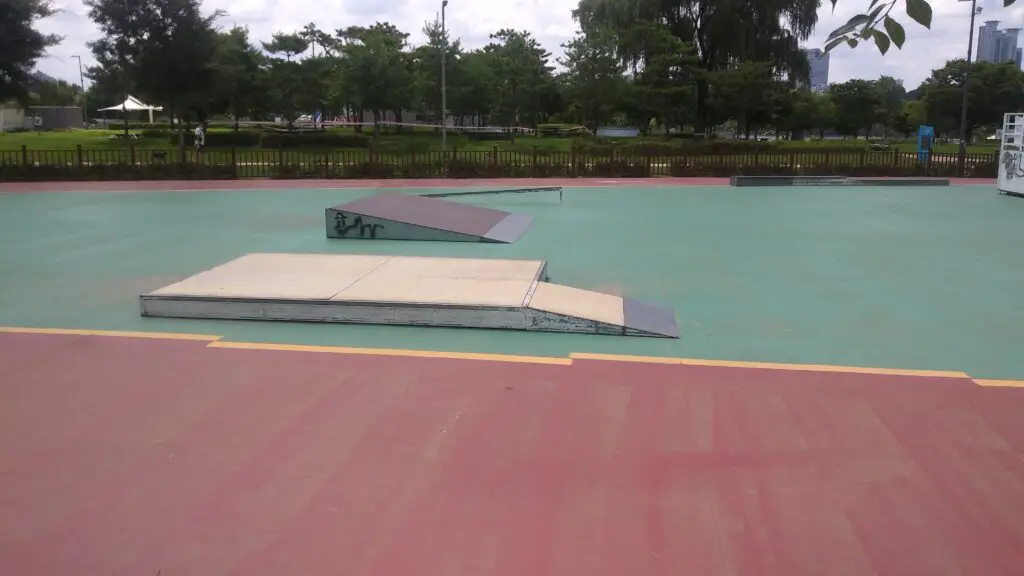
Bowls
Bowls are found in some fashion at almost every skatepark nowadays. If the park doesn’t have a bowl, it usually has a halfpipe.
The bowl can be as shallow as 5-7 feet or as deep as 15-20 feet deep. They are often made of concrete for outdoor parks and sometimes wood for indoor parks. Dropping in and carving these are immensely fun and are the ideal way to skate for older skaters because there isn’t much stress on your body.
Definitely get comfortable on your board first before you try and skate a bowl.
Rails
Rails come in a lot of different varieties and shapes. All the rails in skateparks will be skateable, but not so much in street spots.
Rails can be on platforms, along with stair sets, and simply stand-alone obstacles. The rails themselves can be round or flat and kinked or straight. Kinked means that the rail has a sudden change in direction.
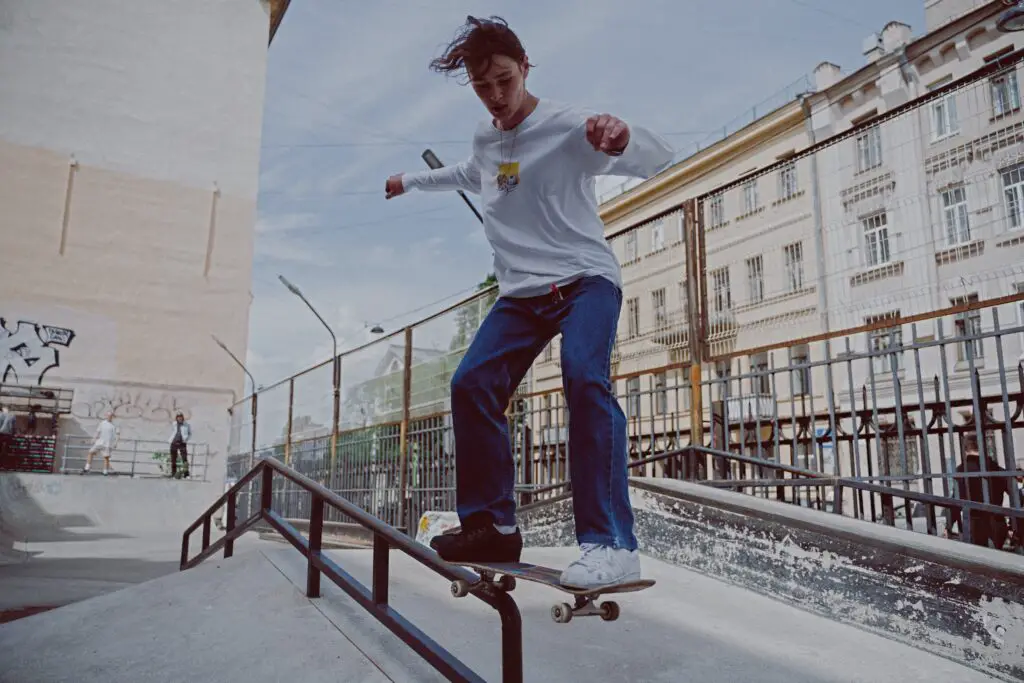
Often the simplest rail will be a simple grind rail that sits about a foot off the ground and can be moved around. These are the best to learn simple grinds on and you can easily purchase one for your own from Amazon or other online retailers. Most skate shops won’t have these in stock as they’re too bulky.
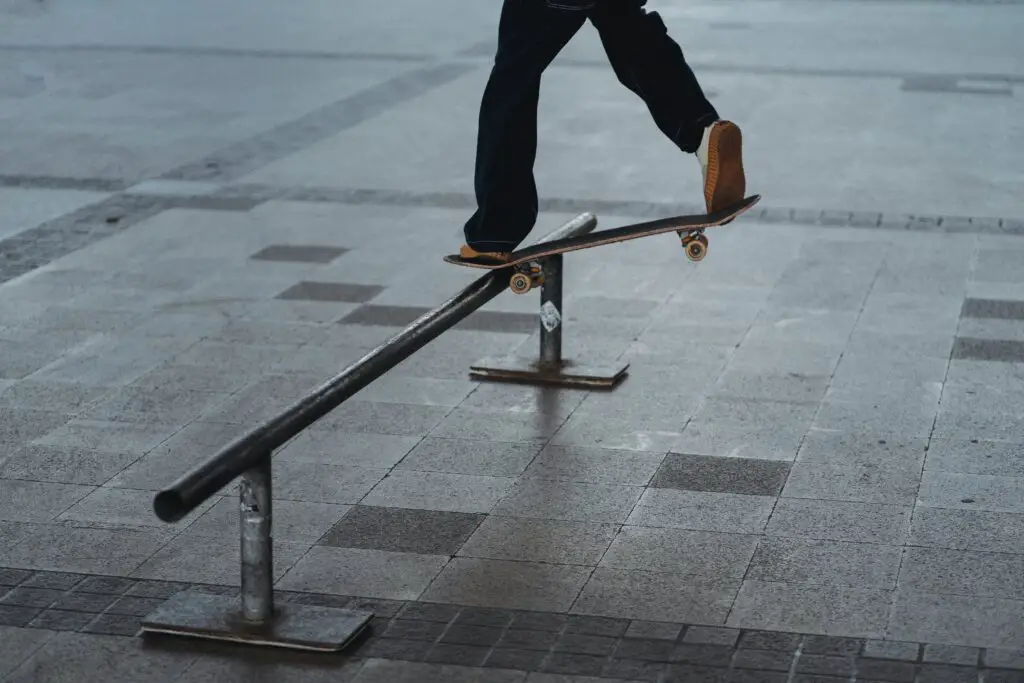
Stairs
Stairs are notorious for street skating and most skateparks feature at least a small stair set. There also might be a down rail alongside the stairs to grind.
If you can’t ollie then I would stay away from the stairs and even if you can ollie you should start off on a small two-step or three-step set before trying anything bigger.
If you’re having confidence issues as most people do, then you can practice just rolling off of a two-step or three-step stair set with no ollie. Just get enough speed and keep the board level with the back tail.
Halfpipes
Halfpipes are quite literally half of a full pipe with the top half being missing. They are what many people think of when they think of skateboarding especially if they’re thinking of Tony Hawk. These aren’t in every skatepark especially if the park is a street-style park, but are still pretty prevalent.
Halfpipes can be very large up to 20 feet tall or rather small which many people call minis. If you’re going to learn then learn on a mini. Falls in concrete bowls or halfpipes are especially dangerous as you are high in the air and you have a good chance to fall backward. When you fall backward, you’re likely going to hit your head.
So please, stay away from these until you’re comfortable with a board. Start on a mini halfpipe and please wear a helmet.
Quarterpipes
Quarterpipes are quite literally a quarter of a pipe. Every skatepark will have one or most likely a few and they are often used to gain speed towards obstacles. You can do any trick you might otherwise do in a bowl or halfpipe on the quarter pipe and they are perfect to start learning transition on.
As a beginner, I would recommend simply riding up and back down switch. Switch means that your dominant foot is in the front and is the position you don’t normally ride in. You can also begin working on your kick turns with a quarterpipe.
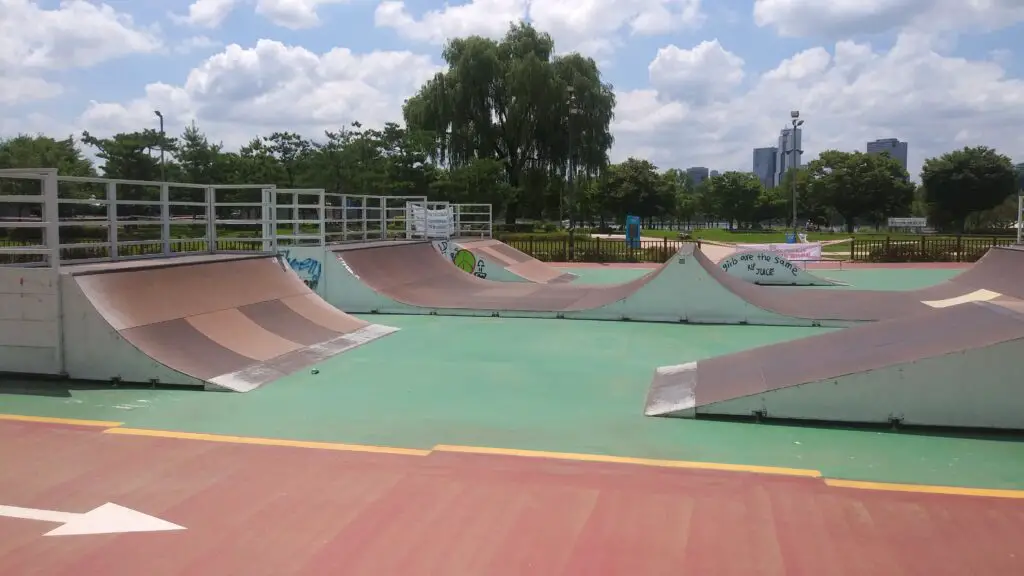
Conclusion
Ok! So that’s the gist of it all. There is some basic etiquette you need to follow at the skatepark, but it’s mostly commonsense.
The best thing to do is to just go. You will make a mistake or feel anxious your first few times going, but that’s normal. The sooner you do it, the sooner you’ll be progressing and comfortable at the skatepark as a beginner.
Thanks for reading and look out for more articles from Board and Wheels.
